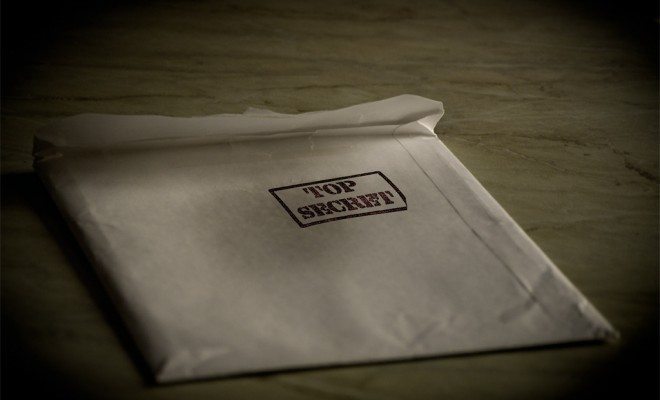 Image courtesy of [Michelangelo Carrieri via Flickr]
Image courtesy of [Michelangelo Carrieri via Flickr]
Law
Trade Secret Laws: Competitive Advantages at Work
Trade secrets are pieces of information that businesses or companies use to gain some sort of competitive advantage. In the United States, we have trade secret laws that allow companies to protect this valuable type of information from being stolen by other companies or individuals. Read on to learn everything you need to know about trade secrets, the laws that protect them, and the arguments for and against these protections.
What Are Trade Secrets?
Under the Uniform Trade Secrets Act, a trade secret is defined as:
Information, including a formula, pattern, compilation, program, device, method, technique, or process that derives independent economic value, actual or potential, from not being generally known to or readily ascertainable through appropriate means by other persons who might obtain economic value from its disclosure or use; and is the subject of efforts that are reasonable under the circumstances to maintain its secrecy.
Some well-known tangible examples of trade secrets include:
- The recipe for Mrs. Fields Chocolate Chip Cookies
- The New York Times bestsellers’ list methodology
- The WD-40 formula
- The Twinkies recipe
- The recipe for McDonald’s Special Sauce
- The Coca-Cola recipe
- Google’s algorithm
Less tangible examples of trade secrets include consumer information or lists. Each of those secrets have made their corresponding products incredibly popular, but should they fall into the hands of competitors, they would lose their competitive advantage.
What are Trade Secret Laws?
Trade secrets are protected by federal law, state law, and contracts between businesses and employees or associates. This triple layer of protection differentiates them from, and in some cases makes them more effective than, patent laws. Trade secret law applies to a much wider range of information than other forms of intellectual property (IP) law, such as patents. Unlike patent protection, which expires after twenty years, trade secret protection does not expire. Trade secret protection does not need to consist of information that is defensible by other IP laws. Even if information does not qualify for patent, copyright, or trademark protection, it can still qualify for trade secret protection. A big, valuable difference between trade secrets and patents is how they’re disseminated to the public. A patented piece of information is owned by the patent holder; they release it into the public and in return get to profit off of it for as long as they own that patent. A trade secret stays secret, and gives the company its competitive value.
Trade secret protection, however, is not applied to information that is common knowledge or is publicly available. For example, if a telemarketing company used the entire phone book as a potential customer list, the company could not claim trade secret protection over the contents of the phone book. Moreover, unlike patents, trade secret protection can be bypassed if the information is obtained independently of the owner of the secret e.g. through reverse engineering or independent or accidental discovery. The protection cannot be circumvented through improper means such as industrial espionage or misappropriation.
Perpetrators of misappropriation of trade secrets can be subject to federal and state civil and criminal liabilities; however, a company must be able to demonstrate that it undertook reasonable methods of protecting the alleged trade secrets in order for trade secret protective legislation to apply. If the company cannot show that it undertook reasonable measures to protect the information, then it can lose its trade secret rights even if it is illegally obtained.
The Uniform Trade Secrets Act
The Uniform Trade Secrets Act was created in 1979 and updated in 1985 in an attempt to create consistent American law across state borders. It was written on the heels of a Supreme Court decision — Kewanee Oil Co. v. Bicron Corp. — that legitimized the use of trade secret laws. After that court decision, many states created their own versions; however, given that many American companies operate across state lines, it’s understandable why consistency was desired.
As of 2013, 47 states, the District of Columbia, Puerto Rico, and the Virgin Islands adopted the UTSA, the only exceptions being New York, Massachusetts, and Texas. Those states have their own laws that provide trade secret protections.
In addition to protecting the trade secrets of companies, the UTSA puts remedies in place for when the laws are breached. These include injunctive relief: essentially a court-ordered prevention from a company using its competitor’s trade secret it obtained, as well as provisions allowing the payment of damages.
What are the benefits of trade secret laws?
Proponents of trade secret protection argue that the law recognizes that a company’s realm of economically valuable information extends beyond patentable and copyrightable content. This gives companies protection from unfair competition. It also alleviates companies’ fears that former employees can weaken their competitive position in the market by working for competitors or selling information. Unlike patents, trade secret protection has no registration costs, takes effect immediately, avoids procedural legal encumbrances, and lasts as long as the company needs.
Trade secret laws also promote collaboration, as strange as that may sound. If two companies embark on some sort of research mission together, they are more likely to be forthcoming and fully collaborative if they know that their confidential information is protected by law.
The Downsides of Trade Secret Laws
Opponents of trade secret protection argue that it gives businesses far too much power. Since the protection lasts until the secrets are discovered, the public’s use of beneficial innovations and freedom of information is restricted in the service of individual profits. Contractual trade secret restrictions can harm employees’ employment availability because the confidentiality and non-compete requirements remain with them after they change employers. These employees are limited in where they are able to work after changing jobs and limited in the knowledge and skills they can employ at any subsequent employment they find.
Case Study: Coca-Cola
The formula for Coca-Cola is one of the most famously sought-after trade secrets in the world. Coke actually loves the mystery surrounding its formula and tries to hype the public up for publicity and marketing reasons:
The history behind the Coca-Cola formula is fascinating, and makes it the perfect example of a trade secret. Starting in 1887, one of the first presidents of the company, Asa Chandler, demanded that no one ever write down the formula again for fear it could be stolen. According to the company, at any given time only two individuals actually know the formula. It is passed down in a ritualized manner, and those two individuals never travel together in case anything tragic ever happens.
New Horizons in Trade Secret Laws
As the world becomes increasingly globalized and the internet is an increasingly important part of the business landscape, trade secret laws are seeing some changes. Trade secret theft is much easier when companies have access to hackers and other tools of corporate espionage. Also, our companies have become not just fluid across state borders, but across international borders as well. American companies are sometimes worried that international competitors, who aren’t necessarily held to the same laws as American companies, will gain hold of valuable trade secrets.
Action in Congress
In light of these concerns, American lawmakers have attempted to strengthen trade secret protections. Earlier this year, two bills were introduced in the House (H.R. 5233: “Trade Secret Protection Act of 2014”) and in the Senate (S. 2267: Defend Trade Secrets Act of 2014.) Both of these bills would create a private federal civil remedy option for companies whose trade secrets have been stolen.
International Action
China, now one of the United States’ most important global trade partners, has attempted to expand its trade secret protections. It is currently working on a trade secret law — it’s in draft status right now — but it’s part of a larger project that China is working on to expand its competition law protections. This action came after the United States had strong disagreements and legal action against China over the possible stealing of trade secrets:
The European Union is also working on strengthening trade secret protection laws. In May 2014, the EU clarified its position on trade secrets, and committed to making consistent laws throughout member countries. A press release from the EU published last winter read:
There are substantial differences in the laws in place in EU countries on protection against trade secret misappropriation. Some countries have no specific laws on the issue. Businesses find it difficult to understand and access the systems of other Member States and, whenever they become victims of misappropriation of confidential know-how, they are reluctant to bring civil court proceedings as they are not sure the confidentiality of their trade secrets will be upheld by the courts. The current fragmented system has a negative effect on cross-border cooperation between business and research partners and is a key obstacle to using the EU single market as an enabler of innovation and economic growth.
Technology and Trade Secrets
Another new frontier in the issue of trade secret protections is protection for technological innovations, such as technology design concepts. Altavion, Inc. v. Konica Minolta Systems Laboratory Inc. was heard in California earlier this year. In this case, a small company called Altavion claimed that a process it had invented to authenticate documents had been stolen by one of its competitors, and that the process was a trade secret. The court ruled in Altavion’s favor.
Conclusion
Trade secrets are an incredibly important part of the American business structure. Many of the United States’ most well-known companies and products have some involvement in trade secrets. While the U.S. has taken admirable actions to protect those secrets, there are constantly new frontiers in the issue, including the advents of technology and globalization. As those topics expand, we should expect to see trade secret protections expand as well.
Resources
Primary
Uniform Trade Secrets Act: Text
Additional
Marquette IP Law Review: Why Do We Have Trade Secrets
Nature: The Good and Bad of Trade Secrets
IP Watchdog: Trade Secrets and Employee Mobility
WIPO: Patents or Trade Secrets?
Unemed: What You Need to Know About Patents and Trade Secrets
King Hall IP Law Assocation: History of Trade Secret Law
Uniform Law Commission: Trade Secrets Act Summary
PeterToren: Criminal Trade Secret laws
Listverse: How Trade Secrets Are Kept
TMS: Federal Trade Secrets Crimes
Hahn Loeser: Does Trade Secret Law also provide patent protection?
Journal of Economic Perspectives: Some Economics of Trade Secret Law
Association of Corporate Counsel: New Texas Trade Secret Law Helps Big Businesses
Beck Reed Riden: Does the Government Favor Businesses With Trade Secrets?
JD Supra: Technology Design Concepts Can be Trade Secrets
Managing IP: Trade Secrets Get Sexy
Buffalo Business First: Looming Changes in Trade Secret Protection
Time: Is this the real thing? Coca-Cola’s Secret Formula “Revealed”








Comments